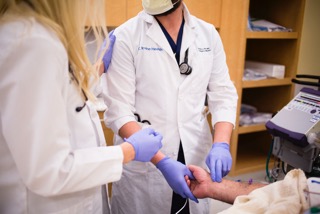Faculty Development
A Longitudinal, Practical Curriculum for Faculty Development as New Coaches in Graduate Medical Education
DOI: https://doi.org/10.21980/J88M08The aim of this curriculum is to provide a longitudinal, practical, and interactive coach training curriculum for faculty with no prior coaching experience.
Cognitive Errors and Debiasing
DOI: https://doi.org/10.21980/J84W96By the end of this lecture, learners should be able to, 1) Define dual process theory, 2) identify common cognitive biases, 3) recognize high-risk situations for cognitive errors, and 3) discuss debiasing strategies and integrate one strategy into your workflow.
Actively Teaching Active Teaching Techniques
DOI: https://doi.org/10.21980/J8H94VBy the end of this small group exercise, learners will be able to: 1) assess interactive teaching techniques that support learning in various environments; 2) incorporate active teaching techniques into a variety of real-world teaching scenarios; 3) implement selected techniques to enrich one’s own teaching practice.
Enneagram in EM
DOI: https://doi.org/10.21980/J8ZM0GBy the end of this session, the learner will be able to: 1) Self-identify with a primary enneagram personality type. 2) List the fears, desires, and motivations of the enneagram type. 3) Describe struggles in interacting with other disparate enneagram types. 4) Discuss strategies for success in facing conflict and interacting with other team members.
Residents Are Coming: A Faculty Development Curriculum to Prepare a Community Site For New Learners
DOI: https://doi.org/10.21980/J87D2NOur goal is to prepare community-based EM attendings to be outstanding educators to future residents by augmenting their knowledge of current educational practice and adult learning theory, literature review, and biostatistics.
Working with Senior Residents: How to get past “You’re doing great!”
DOI: https://doi.org/10.21980/J8D93JABSTRACT: Audience: This content is intended for emergency medicine faculty. Introduction: Faculty at our institution noted that it can be easy to identify and address the knowledge gaps of junior learners. However, they often find different skills are needed when precepting senior residents, a sentiment shared by faculty at other institutions.1 To foster the skills needed for lifelong learning and
Google Forms – A Novel Solution to Blended Learning
DOI: https://doi.org/10.21980/J8BP77By the end of the session, the learner should be able to create a didactic session utilizing Google Forms (or similar web-based application). Specific learning objectives for the didactic session will vary based on application. Our institution has used Google Forms to create case-based small group discussion sessions, “create your own adventure” individual learning cases, asynchronous learning opportunities, and interactive intra-lecture surveys.
A Brief Didactic Intervention to Improve Multiple-Choice Item-Writing Quality
DOI: https://doi.org/10.21980/J81633The primary objective of this training module is to provide emergency medicine residents and faculty the basic knowledge necessary to write high quality structured single-best answer examination items through a brief, independent study format.
A Faculty Development Session or Resident as Teacher Session for Didactic and Clinical Teaching Techniques; Part 1 of 2: Engaging Learners with Effective Didactic Teaching
DOI: https://doi.org/10.21980/J8RP4TBy the end of this workshop, the learner will: 1) describe eight teaching techniques that encourage active learning during didactic sessions; 2) plan a didactic session using at least one of eight new teaching techniques for didactic instruction
A Faculty Development Session or Resident as Teacher Session for Clinical and Clinical Teaching Techniques; Part 2 of 2: Engaging Learners with Effective Clinical Teaching
DOI: https://doi.org/10.21980/J8MW2WBy the end of this workshop, the learner will: 1) describe and implement nine new clinical teaching techniques; 2) implement clinical teaching techniques specific to junior and senior resident learners.


